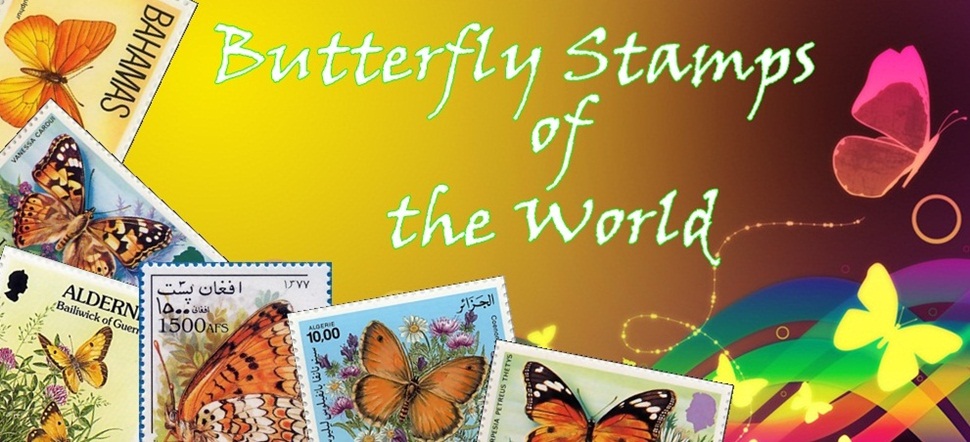The Postal Administrative of Aruba issued the stamp set featured the butterflies species on the first of December 2011. The issues are consist of ten postage stamps. The species depicted are Lycaena heteronea austin, Diaethria neglecta, Lycaena lapidicola, Pyrrhogyra edocla, Anartia amarthea amarthea, Anglais urticae, Morpho aega, Junonia coenia coenia, Dione juno juno.

The Blue Copper (Lycaena heteronea) is a butterfly of the Lycaenidae family. It is found in the western Canada and USA.The males of this species have a bright blue upper-side with faint black spots. The females are greyish brown, with prominent black spots and a blush of orange. The under-side in both sexes is white with black dots.The unique colour of this copper has led to speculation on its convergent evolution with blues. Lycaena heteronea austin feeds as a larva on the same food-plants as blues in the genus Euphilotes.The wingspan is 26–33 mm. Adults are on wing from April to August.

Diaethria neglecta
Diaethria is a brush-footed butterfly genus found in the Neotropical Ecozone, ranging from Mexico to Paraguay. Diaethria neglecta occurs from Panama to Bolivia. The "89" or "88" numerals which appear on the underside hind-wings of this species are present in all of the dozen members of the genus Diaethria, but vary in colour, thickness and shape according to species.
The butterflies often frequent human dwellings, and are considered a sign of good luck by many communities. The upper-sides are blackish, marked on the forewings with a diagonal band of metallic blue or green. In some species this colour is repeated on the hind-wings in the form of a sub-marginal band.
 Lycaena lapidicola
Lycaena lapidicolaLycaena lapidicola or Coppers are members of the Family Lycaenidae. They are found in sunny, open habitats throughout the temperate zone, with 50 species found in Eurasia and North America.
Coppers typically have upper wing surfaces that are iridescent purple or red-orange, but some North American species are blue, brown, or gray. Males perch and interact with other males while awaiting receptive females. Most species have a single brood and overwinter as eggs or as first instar caterpillars within the egg. The caterpillars feed on leaves of host plants , which in North America are docks, knotweeds, buckwheat, cinquefoils, gooseberries, currants, or red berry .

Pyrrhogyra edocla
Pyrrhogyra edocla is a pretty butterfly from Neotropic ecozone (South America). The first description was in 1848 by Doubleday. The wingspan is about 5.0 – 6.0 cm. This butterfly is a member of the family Nymphalidae. Pyrrhogyra edocla is black and white. The underside has red stripes. Pyrrhogyra edocla can be found from Mexico to Brazil.

Anartia amarthea amarthea.
The Brown Peacock or Scarlet Peacock (Anartia amathea) is a species of nymphalid butterfly, found primarily in South America. The type locality is probably Surinam, and the species is found from Panama to Argentina; Grenada, Barbados, Antigua. Larval host plants are mostly include the families Acanthaceae and Labiatae.

Anglais urticae.
The Small Tortoiseshell (Aglais urticae) is a well-known colourful butterfly.It is found in temperate Europe, Asia Minor, Central Asia, Siberia, China, Mongolia, Korea and Japan. This is a species often found in gardens. The caterpillars feed on stinging nettles, as do those of several Nymphalidae butterflies.
The adult is striking, with its dark body and red and yellow wings, which have a row of blue dots around the rear edge. The under-wings are dull, which helps to conceal stationary or hibernating individuals. When threatened, resting individuals rapidly open their wings, presenting the dramatic display of colours. This can frighten away young or inexperienced birds.
 Morpho aega
Morpho aegaThe Aega Morpho (Morpho aega) is a Neotropical butterfly found in Paraguay, Argentina and Brazil. Morpho aega is a species group which may be composed of several species. The larvae feeds on Gramineae.

Junonia coenia coenia.
This butterfly has a distinctive pattern and slightly scalloped wing margins. On the upper-side, all four wings have a large and a small eyespot, the large one on the forewing in a contrasting white band across the wing tip, and there are two orange bands near the costa at the base of the forewing. The underside is paler and the upper-side features are repeated. Females are noticeably larger than males. The wingspan is range 37 to 45 mm.

Junonia coenia coenia
The Common Buckeye (Junonia coenia) is a butterfly in the family Nymphalidae. It is found in southern Manitoba, Ontario, Quebec, and Nova Scotia and all parts of the United States except the northwest, and is especially common in the south, the California coast, and throughout Central America and Colombia.
Its habitat is open areas with low vegetation and some bare ground. This species and its relatives were placed formerly in the genus Precis. Adults feed on nectar and also take fluids from mud and damp sand. Males perch on bare ground or low plants, occasionally patrolling in search of females, but they are not territorial. The caterpillars are solitary and feed on the foliage, flowers, and fruits of the host plant.

Dione juno juno
The Juno Silverspot, Juno Longwing, or Juno Heliconian (Dione juno) is a species of butterflies of the subfamily Heliconiinae in the family Nymphalidae found from southern USA to South America.















